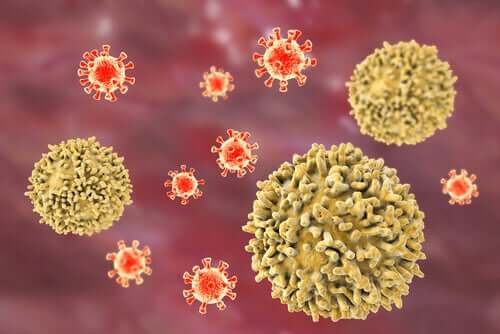How Does a Dog's Immune System Work?

Did you know that animals have an internal defense mechanism? It works against pathogens such as viruses, bacteria, protozoa, and parasites. What is it? Their immune system! A dog’s immune system functions in a similar way to the human immune system. When their bodies are attacked, their immune system responds by making sure the pathogen doesn’t get far in the body.
The first antibodies
When puppies are born, they receive their first antibodies from the first special milk their mother produces, called colostrum. These antibodies will protect the puppies during their first few weeks of life while they develop their own immune system.
What is a dog’s immune system made up of?
The immune system is made up of organs, tissues, cells and tiny molecules. When all of these parts work in harmony, they can effectively act against infectious agents.
Lymphatic glands and the lymph fluid
Lymph is a liquid that is similar to blood plasma. It carries excess interstitial fluid (the fluid that’s in between all the cells in the body), proteins, fats and white blood cells.
Lymph goes around the body through the lymphatic vessels. Lymphatic glands have the job of purifying the lymph fluid and returning it to circulation.
The spleen
The spleen is an organ that directly influences the dog’s immune system. Its job is to filter the blood, destroy old blood cells and produce new cells.
Immune cells
There are different types of immune cells that help the body’s defense system. They are all made in the same place in the body, but each type of cell has a specialized job. When these cells all work together, the body is capable of defending itself against many diseases.
- Lymphocytes. These cells produce antibodies, which are small proteins that can stick to a virus, that is, to the infectious agent that enters the body.
- Macrophages. These cells engulf or swallow up the invasive microorganism. Once they’ve done this, they are able to destroy it. Macrophages also produce substances that call the other immune system cells to action to help attack the infection.
- Dendritic cells. These are similar to macrophages. They also swallow up microorganisms and show a small part of it on their surface to help other immune cells identify and destroy the invaders.
- Neutrophils. These white blood cells are the first cells to show up at the place of infection and they are very abundant.
- Basophils and eosinophils. These cells participate in the inflammation process, allergic reactions and in attacking parasites that invade the body. There aren’t very many of these in the body.

How does a dog’s immune system work during an attack?
The dog’s immune system, as in the case with other mammals, keeps developing as it’s exposed to pathogens. When a pathogen tries to enter the body, there are a series of barriers that impede its entry and reproduction. These are:
- Primary barriers: the skin and mucus secretions.
- Secondary barriers: these are the cells that form the immune system. They prevent the pathogen from spreading throughout the body once it has passed the primary barriers.
In their first months of life, puppies have innate immunity. This is a form of the immune system that immediately responds to the invasion of pathogens. However, it doesn’t learn or remember any of the diseases it comes across.
The cells that make up this early immunity recognize a series of pathogens and respond generically to any threats to the body. As the puppy grows, it’s exposed to new germs, and gradually develops an acquired immunity. Its immune system obtains memories of the diseases and germs that enter the body and becomes more effective the next time the same pathogen tries to invade the body.

How do vaccines work with the immune system?
Vaccines follow this principle. With vaccines, the idea is to ‘teach’ the immune system to combat certain diseases. How? The vaccine presents the immune cells with a weakened version of a specific pathogen, or enough of it for the body to be able to recognize it again.
Vaccinations are a safe way to immunize your dog against serious illnesses such as parvovirus, hepatitis, canine distemper, and leishmania. It’s always a good idea to start when your dog is a puppy. If you carry out the whole course of vaccinations (and booster doses to increase the efficiency of the vaccine), you will improve your dog’s immune system.
Did you know that animals have an internal defense mechanism? It works against pathogens such as viruses, bacteria, protozoa, and parasites. What is it? Their immune system! A dog’s immune system functions in a similar way to the human immune system. When their bodies are attacked, their immune system responds by making sure the pathogen doesn’t get far in the body.
The first antibodies
When puppies are born, they receive their first antibodies from the first special milk their mother produces, called colostrum. These antibodies will protect the puppies during their first few weeks of life while they develop their own immune system.
What is a dog’s immune system made up of?
The immune system is made up of organs, tissues, cells and tiny molecules. When all of these parts work in harmony, they can effectively act against infectious agents.
Lymphatic glands and the lymph fluid
Lymph is a liquid that is similar to blood plasma. It carries excess interstitial fluid (the fluid that’s in between all the cells in the body), proteins, fats and white blood cells.
Lymph goes around the body through the lymphatic vessels. Lymphatic glands have the job of purifying the lymph fluid and returning it to circulation.
The spleen
The spleen is an organ that directly influences the dog’s immune system. Its job is to filter the blood, destroy old blood cells and produce new cells.
Immune cells
There are different types of immune cells that help the body’s defense system. They are all made in the same place in the body, but each type of cell has a specialized job. When these cells all work together, the body is capable of defending itself against many diseases.
- Lymphocytes. These cells produce antibodies, which are small proteins that can stick to a virus, that is, to the infectious agent that enters the body.
- Macrophages. These cells engulf or swallow up the invasive microorganism. Once they’ve done this, they are able to destroy it. Macrophages also produce substances that call the other immune system cells to action to help attack the infection.
- Dendritic cells. These are similar to macrophages. They also swallow up microorganisms and show a small part of it on their surface to help other immune cells identify and destroy the invaders.
- Neutrophils. These white blood cells are the first cells to show up at the place of infection and they are very abundant.
- Basophils and eosinophils. These cells participate in the inflammation process, allergic reactions and in attacking parasites that invade the body. There aren’t very many of these in the body.

How does a dog’s immune system work during an attack?
The dog’s immune system, as in the case with other mammals, keeps developing as it’s exposed to pathogens. When a pathogen tries to enter the body, there are a series of barriers that impede its entry and reproduction. These are:
- Primary barriers: the skin and mucus secretions.
- Secondary barriers: these are the cells that form the immune system. They prevent the pathogen from spreading throughout the body once it has passed the primary barriers.
In their first months of life, puppies have innate immunity. This is a form of the immune system that immediately responds to the invasion of pathogens. However, it doesn’t learn or remember any of the diseases it comes across.
The cells that make up this early immunity recognize a series of pathogens and respond generically to any threats to the body. As the puppy grows, it’s exposed to new germs, and gradually develops an acquired immunity. Its immune system obtains memories of the diseases and germs that enter the body and becomes more effective the next time the same pathogen tries to invade the body.

How do vaccines work with the immune system?
Vaccines follow this principle. With vaccines, the idea is to ‘teach’ the immune system to combat certain diseases. How? The vaccine presents the immune cells with a weakened version of a specific pathogen, or enough of it for the body to be able to recognize it again.
Vaccinations are a safe way to immunize your dog against serious illnesses such as parvovirus, hepatitis, canine distemper, and leishmania. It’s always a good idea to start when your dog is a puppy. If you carry out the whole course of vaccinations (and booster doses to increase the efficiency of the vaccine), you will improve your dog’s immune system.
All cited sources were thoroughly reviewed by our team to ensure their quality, reliability, currency, and validity. The bibliography of this article was considered reliable and of academic or scientific accuracy.
- Universidad de Granada. Curso de inmunología general.
- Peter J. Delves, MSD manuals. Inmunidad innata.
- Medineplus. Respuesta inmunitario
This text is provided for informational purposes only and does not replace consultation with a professional. If in doubt, consult your specialist.








